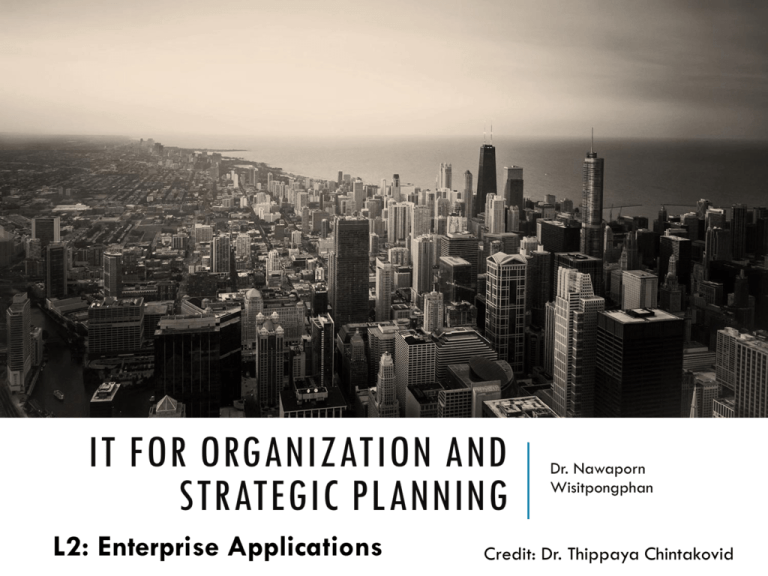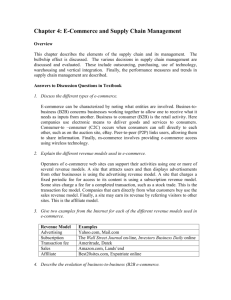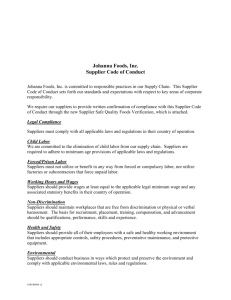now
advertisement

IT FOR ORGANIZATION AND STRATEGIC PLANNING L2: Enterprise Applications Dr. Nawaporn Wisitpongphan Credit: Dr. Thippaya Chintakovid REFERENCE READING K.C. Laudon and J.P. Laudon, “Management Information System: Managing the Digital Firm” Chapter 3 http://paginas.fe.up.pt/~als/mis10e/chapter3main.htm E. Turban, “Information Technology for Management: Transforming Organizations in the Digital Economy” Interdependence between organizations and information systems Hardware Business Strategic Objectives Business Processes Business Firms Software Information System Data Mgmt Telecommunications Six Strategic Business Objectives • • • • • • Operational Excellence New Products, Services, and Business Models Customer and Supplier Intimacy Improved Decision Making Competitive Advantage Survival Operational Excellence RetailLink system • digitally links its suppliers to every WalMart’s stores • supplier knows to ship a replacement to the shelf as soon as a customer buys an item New Products, Services, and Business Models • New business model of music distribution Customer and Supplier Intimacy • Keep track of guests’ preferences (room temperature, check-in time, etc.) • Automatically adjust room settings when the customer arrives Improved Decision Making • Use web-based dashboard to present real-time information (network performance, line outage) • Can effectively allocate repair resources Competitive Advantage • Competitive Advantage = doing things better than your competitors (charging less, responding faster) Survival • Citibank introduced ATMs in 1977 • Other banks, then, needed to provide ATMs to survive in the business Generic Strategies • Four generic strategies for dealing with competitive forces, enabled by using IT • Low-cost leadership • Product differentiation • Focus on market niche • Strengthen customer and supplier intimacy Low-cost leadership RetailLink system • digitally links its suppliers to every WalMart’s stores • pay only 16.6 % of sales revenue for overhead (cf. 20.7%) • supplier knows to ship a replacement to the shelf as soon as a customer buys an item Product Differentiation • Google Maps •Portable digital music player •Online Web music service • Paypal -> easier for customers to pay sellers Focus on Market Niche • use information systems to analyze customer buying patterns, tastes, preferences • know customers better -> better advertising and marketing campaigns • input data •Credit card transactions •Demographic data •Data from checkout counter scanners •Data from users’ interaction with Web sites Customer and supplier intimacy • use information systems to facilitate direct access by suppliers to production schedules -> more lead time in producing goods •strong linkages to customers and suppliers increase switching costs and loyalty to your firms Enterprise Systems Enterprise Systems • Enterprise Systems • Aka enterprise resource planning (ERP) systems • Suite of integrated software modules and a common central database • Collects data from many divisions of firm for use in nearly all of firm’s internal business activities • Information entered in one process is immediately available for other processes Enterprise Systems • Enterprise Software • Built around thousands of predefined business processes that reflect best practices • Finance/accounting: General ledger, accounts payable, etc. • Human resources: Personnel administration, payroll, etc. • Manufacturing/production: Purchasing, shipping, etc. • Sales/marketing: Order processing, billing, sales planning, etc. • To implement, firms: • Select functions of system they wish to use • Map business processes to software processes • Use software’s configuration tables for customizing Enterprise Systems • Business Value of Enterprise Systems • Increase operational efficiency • Provide firmwide information to support decision making • Enable rapid responses to customer requests for information or products • Include analytical tools to evaluate overall organizational performance How Enterprise Systems Work Enterprise systems feature a set of integrated software modules and a central database that enables data to be shared by many different business processes and functional areas throughout the enterprise Supply Chain Management Systems Supply Chain Management Systems • The supply chain • Network of organizations and processes for: • Procuring raw materials • Transforming them into products • Distributing the products • Upstream supply chain: • Firm’s suppliers, suppliers’ suppliers, processes for managing relationships with them • Downstream supply chain: • Organizations and processes responsible for delivering products to customers Nike’s Supply Chain This figure illustrates the major entities in Nike’s supply chain and the flow of information upstream and downstream to coordinate the activities involved in buying, making, and moving a product. Shown here is a simplified supply chain, with the upstream portion focusing only on the suppliers for sneakers and sneaker soles. Supply Chain Management Systems • Information and supply chain management • Inefficiencies cut into a company’s operating costs • Can waste up to 25% of operating expenses • Just-in-time strategy: • Components arrive as they are needed • Finished goods shipped after leaving assembly line • Safety stock • Buffer for lack of flexibility in supply chain • Bullwhip effect • Information about product demand gets distorted as it passes from one entity to next across supply chain The Bullwhip Effect Inaccurate information can cause minor fluctuations in demand for a product to be amplified as one moves further back in the supply chain. Minor fluctuations in retail sales for a product can create excess inventory for distributors, manufacturers, and suppliers. Supply Chain Management Systems • Supply chain management systems • Supply chain planning systems • Model existing supply chain • Demand planning • Optimize sourcing, manufacturing plans • Establish inventory levels • Identifying transportation modes • Supply chain execution systems • Manage flow of products through distribution centers and warehouses Supply Chain Management Systems • Demand-driven supply chains • Push-based model (build-to-stock) • Schedules based on best guesses of demand • Pull-based model (demand-driven) • Customer orders trigger events in supply chain • Sequential supply chains • Information and materials flow sequentially from company to company • Concurrent supply chains • Information flows in many directions simultaneously among members of a supply chain network Push- Versus Pull-Based Supply Chain Models The difference between push- and pull-based models is summarized by the slogan “Make what we sell, not sell what we make.” Supply Chain Management Systems Business Value of Supply Chain Management Systems • Match supply to demand • Reduce inventory levels • Improve delivery service • Speed product time to market • Use assets more effectively • Reduced supply chain costs • Increased sales Customer Relationship Management Systems Customer Relationship Management Systems • What is customer relationship management? • Knowing the customer • In large businesses, too many customers and too many ways customers interact with firm • Customer relationship management (CRM) systems • Capture and integrate customer data from all over the organization • Consolidate and analyze customer data • Distribute customer information to various systems and customer touch points across enterprise • Provide single enterprise view of customers Customer Relationship Management CRM systems examine customers from a multifaceted perspective. These systems use a set of integrated applications to address all aspects of the customer relationship, including customer service, sales, and marketing. Customer Relationship Management Systems • CRM software packages • Most packages have modules for • Sales force automation (SFA): Sales prospect and contact information, and sales quote generation capabilities; etc. • Customer service: Assigning and managing customer service requests; Web-based selfservice capabilities; etc. • Marketing: Capturing prospect and customer data, scheduling and tracking direct-marketing mailings or e-mail; etc. Customer Relationship Management Systems • Business value of customer relationship management • Increased customer satisfaction • Reduced direct-marketing costs • More effective marketing • Lower costs for customer acquisition/retention • Increased sales revenue • Reduced churn rate • Churn rate: • Number of customers who stop using or purchasing products or services from a company. • Indicator of growth or decline of firm’s customer base E-Commerce & M-Commerce E-Commerce • E-commerce • Use of the Internet and Web to transact business • Digitally enabled transactions E-Commerce • Interactive marketing and personalization • Web sites are bountiful source of details about customer behavior, preferences, buying patterns used to tailor promotions, products, services, and pricing • Clickstream tracking tools: Collect data on customer activities at Web sites • Used to create personalized Web pages • Collaborative filtering: Compares customer data to other customers to make product recommendations Web Site Visitor Tracking E-commerce Web sites have tools to track a shopper’s every step through an online store. Close examination of customer behavior at a Web site selling women’s clothing shows what the store might learn at each step and what actions it could take to increase sales. M-Commerce • M-commerce services and applications • Location-based services • Banking and financial services • Wireless Advertising • Games and entertainment Knowledge Management Systems Knowledge Management Systems • Important dimensions of knowledge • Knowledge is a firm asset • Intangible • Creation of knowledge from data, information, requires organizational resources • As it is shared, experiences network effects • Knowledge has different forms • • • • May be explicit (documented) or tacit (residing in minds) Know-how, craft, skill How to follow procedure Knowing why things happen (causality) Knowledge Management Systems • Important dimensions of knowledge (cont.) • Knowledge has a location • Cognitive event • Both social and individual • “Sticky” (hard to move), situated (enmeshed in firm’s culture), contextual (works only in certain situations) • Knowledge is situational • Conditional: Knowing when to apply procedure • Contextual: Knowing circumstances to use certain tool The Knowledge Management Value Chain Knowledge management today involves both information systems activities and a host of enabling management and organizational activities. Major Types of Knowledge Management Systems There are three major categories of knowledge management systems, and each can be broken down further into more specialized types of knowledge management systems. Management Information Systems & Decision Support Systems Management Information Systems & Decision Support Systems • Business value of improved decision making • Improving hundreds of thousands of “small” decisions adds up to large annual value for the business • Types of decisions: • Unstructured: Decision maker must provide judgment, evaluation, and insight to solve problem • Structured: Repetitive and routine; involve definite procedure for handling so they do not have to be treated each time as new • Semistructured: Only part of problem has clear-cut answer provided by accepted procedure Information Requirements of Key Decision-Making Groups in a Firm Senior managers, middle managers, operational managers, and employees have different types of decisions and information requirements. Management Information Systems & Decision Support Systems • Four kinds of systems for decision support • Management information systems (MIS) • Decision support systems (DSS) • Executive support systems (ESS) • Group decision support systems (GDSS) Management Information Systems & Decision Support Systems • Management information systems (MIS) • Help managers monitor and control business by providing information on firm’s performance and address structured problems • Typically produce fixed, regularly scheduled reports based on data from TPS • E.g., exception reports: Highlighting exceptional conditions, such as sales quotas below anticipated level • E.g., California Pizza Kitchen MIS • For each restaurant, compares amount of ingredients used per ordered menu item to predefined portion measurements and identifies restaurants with out-of-line portions Management Information Systems & Decision Support Systems • Decision-support systems (DSS) • Support unstructured and semistructured decisions • Model-driven DSS • Earliest DSS were heavily model-driven • Data-driven DSS • Some contemporary DSS are data-driven • Use OLAP and data mining to analyze large pools of data • E.g., business intelligence applications Management Information Systems & Decision Support Systems • Group decision support systems (GDSS) • Interactive system to facilitate solution of unstructured problems by group of decision makers • Hardware – computer and networking hardware, overhead projectors, display screens • GDSS software collects, documents, ranks, edits and stores participant ideas, responses • May require facilitator and staff • Enables increasing meeting size and increasing productivity • Promotes collaborative atmosphere, guaranteeing anonymity • Follow structured methods for organizing and evaluating ideas and preserving meeting results Management Information Systems & Decision Support Systems • Executive support systems (ESS) • Designed to help executives focus on important performance indications • Balanced scorecard method: • Measures outcomes on four dimensions: • Financial • Business process • Customer • Learning & growth • Key performance indicators (KPIs) measure each dimension • In developing an ESS, first concern is for senior executives and consultants to develop scorecard and then to automate flow of information for each KPI Management Information Systems & Decision Support Systems • Business value of executive support systems • Enables executive to review more data in less time with greater clarity than paper-based systems • Needed actions identified and carried out earlier • Improves management performance • Increases upper management’s span of control • Also enables decision making to be decentralized and take place at lower operating levels • Increases executives’ ability to monitor activities of lower units reporting to them









